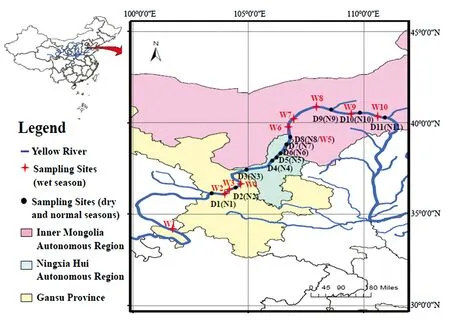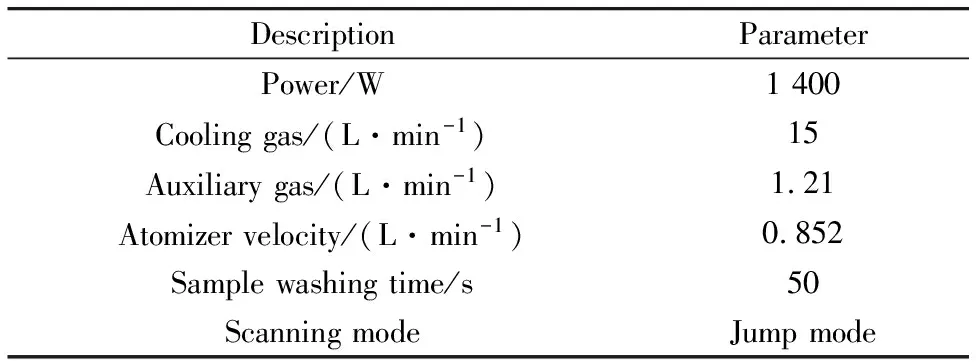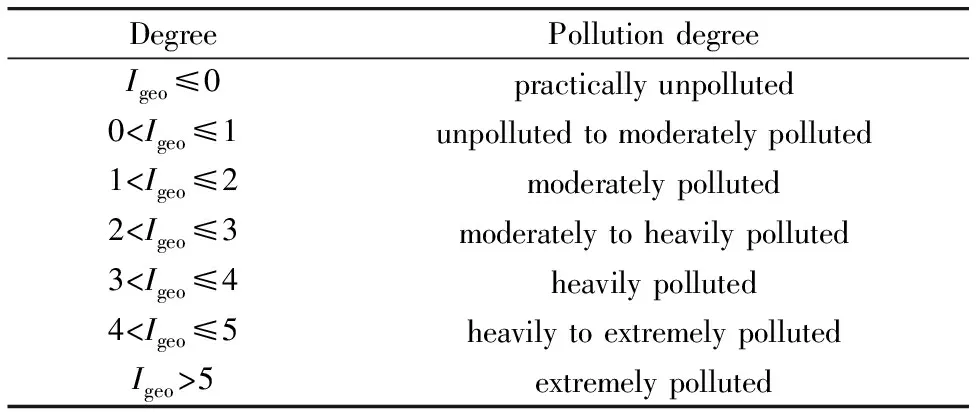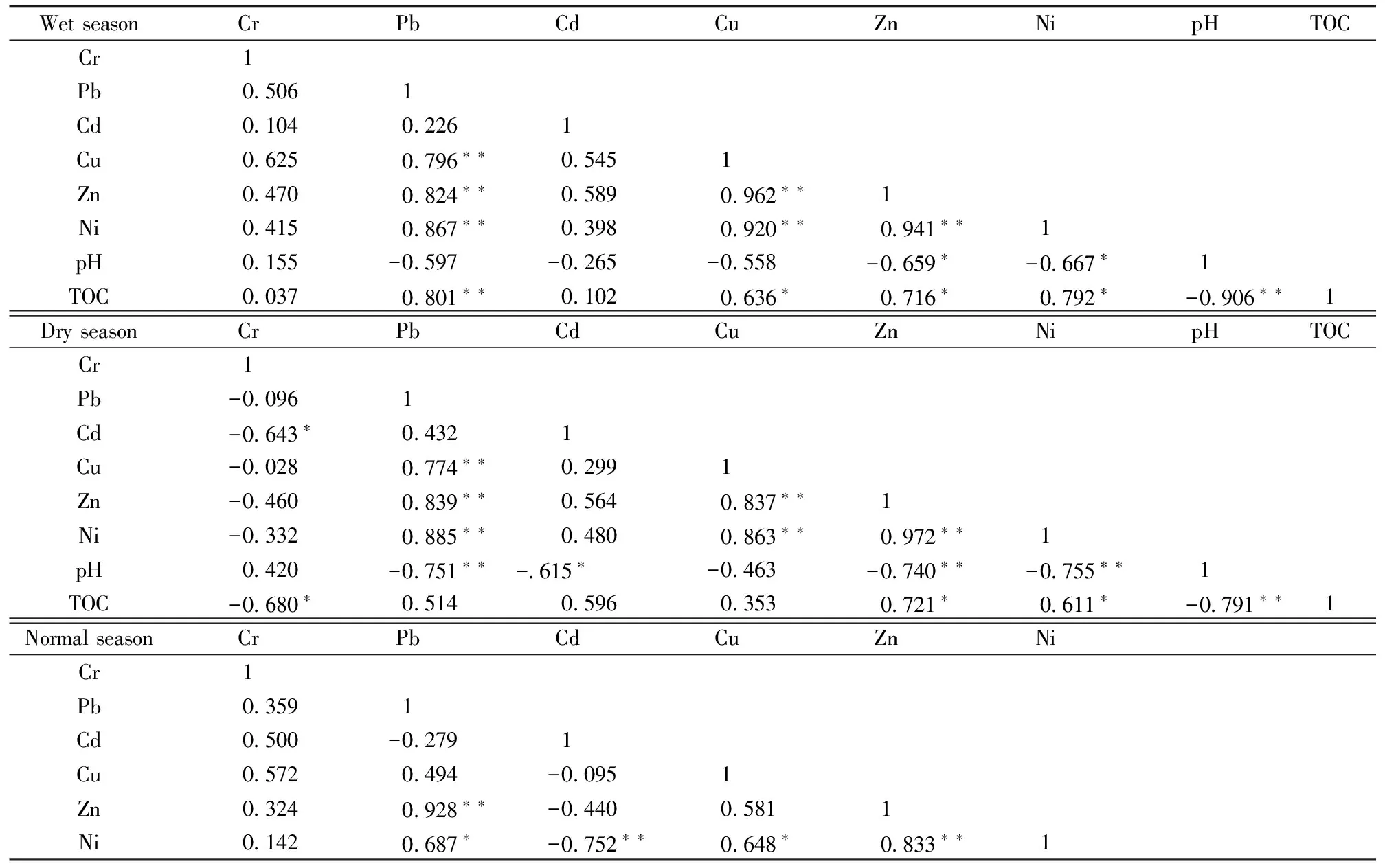Study on Spatial Distribution and Seasonal Variations of Trace Metal Contamination in Sediments from the Three Adjacent Areas of the Yellow River Using HR-ICP-MS
2016-06-15MAXiaolingDENGFengyuLIUYing
MA Xiao-ling, DENG Feng-yu, LIU Ying,2*
1. College of Life and Environmental Sciences, Minzu University of China, Beijing 100081, China
2. Beijing Engineering Research Center of Food Environment and Public Health, Minzu University of China, Beijing 100081, China
Study on Spatial Distribution and Seasonal Variations of Trace Metal Contamination in Sediments from the Three Adjacent Areas of the Yellow River Using HR-ICP-MS
MA Xiao-ling1, DENG Feng-yu1, LIU Ying1,2*
1. College of Life and Environmental Sciences, Minzu University of China, Beijing 100081, China
2. Beijing Engineering Research Center of Food Environment and Public Health, Minzu University of China, Beijing 100081, China

Spatial distribution; Seasonal variations; Heavy metal; Sediments; the Yellow River
Introduction
Heavy metal contamination has become a serious concern in ecosystem especially in aquatic environment due to its toxicity, bioaccumulation capacity and persistence in recent decades. In some condition, more than 99% of metals entering into river can be stored in the surface sediments. Sediments can be the environmental indicators for their ability to trace metal contamination sources and act as both carriers and potential sources for heavy metals in aquatic environment[1]. The concentrations of metals in sediments can vary differently with the seasons and sediment properties like pH, total organic carbon (TOC) and redox condition change since the metals binding basically depend on the surrounding environment condition. The high resolution inductively coupled plasma-mass spectrometry (HR-ICP-MS) have been widely used to trace elements determination since it enables exact calibration and accurate quantification unaffected by the matrix[2].
As the extremely important water source of northwest and north China, the Yellow River had its water quality decreased significantly with the reason that rapid socio-economic development and urbanization of the China from the 1960s[3]. Being the major grains producing areas in China, Gansu province, Ningxia and Inner Mongolia autonomous regions, the three adjacent and developing regions along the Yellow River, they have their pillar industries with agriculture, forestry, mining and animal husbandry, which are strongly dependent on the water resources from the Yellow River[4]. Studies of various mineralogical, biological and physicochemical aspects of the Yellow River have been carried out, but limited data are available on the distribution and seasonal variation of metal concentrations in the sediments of these three reaches of the Yellow River[5]. Therefore, investigating the distributions mechanisms for sedimentary heavy metals in different seasons in these three reaches of the Yellow River has become necessary, which could interpret accumulation of pollutants and provide basic information for coast utilization and supervision.
The objectives of present study are to: (1) investigate the spatial distribution and seasonal variations of heavy metals (Cr, Pb, Cd, Cu, Zn and Ni) in surface sediments in Gansu, Ningxia and Inner Mongolia reaches of the Yellow River by using HR-ICP-MS; (2) assess the sediments quality by using geo-accumulation index (Igeo); (3) and identify the contributing sources of heavy metals in sediment samples with the help of correlation coefficient analysis (CCA).
1 Materials and methods
1.1 Samples collection
Surface sediments (top 10 cm) were collected by using a simple sampler in Gansu, Ningxia and Inner Mongolia sections of the Yellow River in July 2012 (wet season, 10 samples including W1—W10), May (dry season, 11 samples including D1—D11) and October (normal season, 11 samples including N1—N11) 2014, respectively, as indicated in the map (Fig.1). Most samples collected in wet season were situated at the national control sections (NCS), and most samples in dry and normal seasons are nearby various industries. Sediments samples are bagged, labeled and returned to the laboratory in acid-rinsed polyethylene plastic bags in an icebox.

Fig.1 Map showing station locations
1.2 Analytical methods
Concentrations of Cr, Pb, Cd, Cu, Zn and Ni in sediments samples are determined by using of HR-ICP-MS (Element I, USA) according to GB/T 14506.30—2010, and the instrumental operating parameters of HR-ICP-MS are showed in Table 1. The standard method DZ/T 0064.5—1993 and SY/T 5116—1997 are employed to determine the pH values and TOC concentrations in sediments samples in wet and dry seasons, respectively.
1.3 Pollution assessment
Pollution levels of heavy metals in sediments in present work could be characterized byIgeo, which has commonly been cited by researchers in environmental studies and could be defined by the following equation[6]
Where,Cnis the measured content of the metal n,Bnis the background or pristine value of metal n. The constant factor 1.5 is used for possible lithological variations in the background value base on Shale value reported previously. The heavy metal pollution degree is showed in Table 2.

Table 1 The instrumental operating

Table 2 Pollution degree of Igeo for heavy metals
1.4 Source identification
Correlation coefficient analysis (CCA) is a useful method which can measure the correlativity among heavy metals and other variables, and it could also identify the potential sources of the metals, which is performed by using the commercial statistics software package SPSS version 19.0 for Windows[7].
2 Results and discussions
2.1 Spatial distribution of heavy metals in sediments of the Yellow River
The distribution patterns of total metal concentrations measured at different sites in three seasons are summarized in Fig.2. The concentration ranges and mean values for each heavy metal in sediments are found as follows (mg·kg-1):
In wet season Cr: 43.17~85.10 (68.31); Pb: 15.12~50.44 (22.63); Cd: 0.07~0.43 (0.22); Cu: 22.04~57.64 (38.10); Zn: 57.97~114.43 (79.20); Ni: 19.18~52.45 (32.12). The highest concentrations of all study metals are observed in Inner Mongolia region (W10) with the exception of Cd (W3), while the lowest concentrations of all metals except Cd (W7) are found in Gansu region (W1).
In dry season Cr: 61.29~139.52 (83.99); Pb: 16.80~24.61 (18.77); Cd: 0.11~0.27 (0.16); Cu: 14.12~30.25 (19.18); Zn: 39.39~74.64 (52.58); Ni: 19.33~34.62 (24.33). The highest concentrations of Pb, Zn and Ni are obtained in Ningxia region (D8).
In normal season Cr: 53.60~65.50 (61.51); Pb: 14.70~17.60 (15.67); Cd: 0.24~0.65 (0.39); Cu: 15.30~20.40 (18.03); Zn: 49.20~63.20 (55.22); Ni: 20.20~25.30 (22.50). The highest concentrations of Pb, Cu, Zn and Ni are measured in Inner Mongolia region (N9), when the lowest values of these four metals are also found in Mongolia region (N10). This result obtained is different from the metal concentrations in dry season, although the study heavy metals in sediment samples are collected from the same sites.

Fig.2 Concentrations of heavy metals in different seasons
In general, except Cd, the other metals concentrations in wet season are relatively higher, and they are lower and approximated in dry and normal seasons. The concentrations of Cd follow the decreasing order: Cd (normal season)>Cd (wet season)~Cd (dry season). The average concentrations (AC) of all heavy metals in sediment samples of three regions of the Yellow River can be summarized as following: AC (Inner Mongolia)>AC (Gansu)>AC (Ningxia) for wet season; AC (Inner Mongolia)>AC (Ningxia)>AC (Gansu) for dry season, and AC (Inner Mongolia)>AC (Gansu)>AC (Ningxia) for normal season.
2.2 Heavy metal pollution assessment


Fig.3 Igeo values for heavy metals in different seasons
Combining the results of spatial distribution andIgeoof study heavy metals, it should be noted that:
(1) For three different regions, considering the results obtained in wet and dry seasons, higher total metal concentrations and potential risks are found in Ningxia and Inner Mongolia reaches of the Yellow River, especially for Inner Mongolia reach, and Cr, Cd and Cu are being more significant with a strong anthropogenic source among all study metals, while lower risks are observed in Gansu region. Industrial effluent discharged and municipal sewage are two major sources to attribute the heavy metal pollution. It is well documented that industrial activities such as smelting of steel and nonferrous metals are important sources for anthropogenic heavy metals[8]. Inner Mongolia is famous for its steel and rare earth industries, which greatly promote the increase of its GDP[5]. There are variety industries including leather, pharmaceutical and electrical appliances industries in Ningxia, and they are the main sources for Cr, Cd and Cu, the higher risks in Inner Mongolia and Ningxia reaches of the Yellow River may be attributed to the wastes discharge from these industries.
(2) For three different seasons, except normal season, the higher metal concentrations and potential risks for metals in sediments are found in wet season in comparison to dry season. The risks of all metals except Cd are decreased in normal season, while that of Cd is increased evidently and be hazardous to all sampling sites. The causes of these phenomena may be attributed to:
① High pH values can promote adsorption and precipitation, while low pH could actually weaken the strength of metal association and impede the retention of metals by sediments[9]. The pH values in the sedimentary samples are 9.40, 9.61, 9.65, 9.66, 9.31, 9.62, 9.96, 9.58, 9.53, 9.21 for sampling sites W1—W10 in wet season, respectively, and 9.47, 9.56, 9.51, 9.41, 9.48, 9.37, 9.36, 9.17, 9.57, 9.49, 9.62 for sampling sites D1—D11 in dry season, respectively, which indicate an alkaline environment in study areas. The pH in wet season is relatively higher than dry season, which is not conducive to the release of heavy metals from the sediments to water phase, thus there will be a higher metals concentrations in the sediments in wet season rather than dry season.
② The presence of TOC in sediments is beneficial to the adsorption of heavy metals since the affinity between TOC and metal cations[10]. The TOC values in the sedimentary samples are 0.30, 0.17, 0.12, 0.08, 0.41, 0.16, 0.07, 0.19, 0.24, 0.61 for sampling sites W1—W10 in wet season, respectively, and 0.27, 0.18, 0.22, 0.32, 0.22, 0.26, 0.28, 0.34, 0.27, 0.22, 0.11 for sampling sites D1—D11 in dry season, respectively. The TOC values in sediments in Inner Mongolia reach in wet season are slightly higher than that of dry season, and the highest values of TOC (0.61) is found in W10. High TOC concentrations at these sites in wet season can combine the more heavy metals when compared to that of dry season.
③ Besides, a lot of coast sediments with variety pollutants are brought into the river by rainfall in summer, which may has resulted in a rapid enrichment of heavy metals in sediments in wet season than dry season.
我何庆林,字云乔,别署近鸥堂。1974年生于四川梓潼。2002年毕业于中国美术学院中国画系山水画专业。现为杭州画院专职画师、中国美术家协会会员、中华诗词学会会员。
④ The increased risks for Cd at all sampling sites in normal season indicate the strong anthropogenic sources there.
2.3 Source identification
The correlation coefficients for heavy metals, pH and TOC in sediments samples are presented in Table 3. The correlations of variables among three seasons can be concluded as following: In wet season: (1) Pb-Cu-Zn-Ni-TOC; (2) Zn-Ni-pH; (3) pH-TOC. In dry season: (1) Pb-Cu-Zn-Ni-pH; (2) Zn-Ni-pH-TOC; (3) Cr-Cd-TOC; (4) pH-TOC. In normal season: (1) Pb-Zn-Ni; (2) Ni-Cu-Cd.
In general, Pb, Cu, Zn and Ni show a significant correlation with each other. Coal burning, iron and steel smelting and non-ferrous metal smelting are important sources of Pb. Cu level could be influenced more by agricultural activities. On the other hand, Zn could come from the schistose rocks with sulfide seams and Ni contaminations could result from the erosion of mafic and ultramafic rocks[11]. Based on the distribution patter of heavy metals (Fig.2), the average values of these heavy metals are all below or near their background levels, but the results ofIgeoshow these metals are little harmful in Inner Mongolia region in wet season. Therefore, CCA suggests that Pb, Cu, Zn and Ni are mainly controlled by the geological background in Gansu and Ningxia regions, while they have been little influenced from human activity in Inner Mongolia region. Notably, pH and TOC show a significant correlation among three seasons and they are highly associated with these metals, indicating they are readily influenced by pH and TOC.

Table 3 The correlation matrix for heavy metals in different seasons
**: Correlation is significant at the 0.01 level (2-tailed);
*: Correlation is significant at the 0.05 level (2-tailed)
Cr shows a correlation with Cd and TOC in dry season. Cr could be the results of the weathering of mafic/ultramafic rocks, mining and other industrial activities. In addition, Cd could cause from the wastes emissions of electroplating, metallurgy and other industries, and it also could be affected by the application of fertilizers and pesticides[12]. In this work, in view of the high total concentrations (Fig.2) andIgeo(Fig.3) values of Cr and Cd, especially for Cd in all sediment samples in three seasons, so the two metals would be mainly derived from anthropogenic sources, particularly metallic discharges of the various industrial and sewage discharges of local residents[3]. The intimate relationship between Cr/Cd with TOC may further verify that TOC may play an important role in the presence of the metals.
3 Conclusions
Igeoand CCA are exploited to assess the potential risks for heavy metals in sediments in three adjacent regions of the Yellow River. The results of spatial distribution of heavy metals in sediments investigated by HR-ICP-MS obviously indicate that the Inner Mongolia region contains higher total metal concentrations and with high potential risks in comparison with Ningxia and Gansu regions based on the results obtained in wet and dry seasons. Meanwhile, the potential risks of heavy metals in wet season are relatively higher on the basis ofIgeo, while in dry and normal seasons, that are found to be lower and approximate. Furthermore, Cr, Cd and Cu, especially for Cd, may be likely hazards to human being and aquatic biotic and reflecting strong anthropogenic source when compared to other investigated metals in study regions, while Pb, Cu, Zn and Ni are relatively safer to the environment, and they show significant correlations with pH and TOC, implying they may easily influenced by pH and TOC according CCA. The measurement of heavy metals distribution and risk in the sediments could lead to better understanding of their behavior in the aquatic environments and is important for detecting sources of pollution.
[1] Peng J F, Song Y H, Yuan P, et al. J. Hazard. Mater., 2009, 161(2-3): 633.
[2] Vogl J, Heumann K G. Fresen. J. Anal. Chem., 1997, 359(4-5): 438.
[3] Huang L L, Pu X M, Pan J F, et al. Chemosphere, 2013, 93(9): 1957.
[4] Huang J, Xue Y, Sun S L, et al. Quatern. Int., 2015, 355:134.
[5] Liu J J, Liu Y. Spectrosc. Spectr. Anal., 2013, 33(12): 3249.
[6] Abrahim G M S, Parker R J. Environ. Monit. Assess., 2008, 136(1-3): 227.
[7] Chen X D, Lu X W, Yang G. Catena, 2012, 98: 73.
[8] Nriagu J O. Nature, 1979, 279: 409.
[9] Zhang C, Yu Z G, Zeng G M, et al. Environ. Int., 2014, 73: 270.
[10] Daskalaskis K D, O’Connor T P. Environ. Sci. Technol., 1995, 29(2): 470.
[11] Chen B, Fan D J, Li W R, et al. Cont. Shelf Res., 2014, 90: 163.
[12] Mamat Z, Yimit H, Ji R Z A, et al. Sci. Total Environ., 2014, 493: 1098.
*通讯联系人
O657.3
A
HR-ICP-MS研究黄河三个连续区域段表层沉积物中重金属污染的空间分布和季节变化
马小玲1, 邓凤玉1, 刘 颖1,2*
1. 中央民族大学生命与环境科学学院, 北京 100081
2. 中央民族大学北京市食品环境与健康工程技术研究中心, 北京 100081

空间分布; 季节变化; 重金属; 表层沉积物; 黄河
2015-06-18,
2015-11-12)
2015-06-18; accepted: 2015-11-12
The National Natural Science Foundation of China (21177163), 111 Project B08044, First-class University First-class Academic Program of Minzu University of China (YLDX01013), Coordinate Development of First-Class and First-Class University Discipline Construction Funds(10301-0150200604), The Academic Team Construction Project of Minzu University of China (2015MDTD25C&13C), First-class Universities and First-class Discipline Construction Transitional Funds Under Special Funding (10301-01404031, 2015), Graduate Student Scientific Research Innovation Project of Minzu University of China (K2014042), GCCX2015
10.3964/j.issn.1000-0593(2016)08-2705-07
Biography: MA Xiao-ling, (1990—), Master of College Life and Environmental Sciences, Minzu University of China e-mail: mxl3884@126.com *Corresponding author e-mail: liuying4300@163.com
